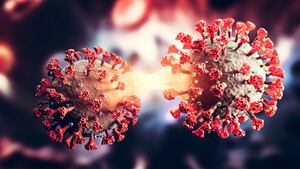Just a couple weeks ago it seemed like the worst was behind us and the wave of COVID-19 infections driven by the new Omicron variant was beginning to ebb in many of the worst-hit places.
But epidemiologists warned that some new variant would eventually replace Omicron, potentially driving a new surge in cases. They were right.
This week, cases started rising again in several countries. And some experts think an elusive form of Omicron, the so-called BA.2 sublineage, might be responsible.
If that’s the case and BA.2 proves even more transmissible than baseline Omicron—the BA.1 sublineage–then we should brace for a difficult spring. BA.2 is already making inroads in the U.S. It could slow or even reverse our recovery from the first Omicron wave.
Don’t panic quite yet. But don’t let down your guard. And if you’re unvaccinated or unboosted, you know the drill. Yesterday was the best time to get your jab.
Scientists have known about BA.2 for weeks now. They first detected it in early December in samples from South Africa, Australia, and Canada. That was just a few weeks after officials from South Africa announced the first BA.1 cases.
BA.1—again, that’s the baseline Omicron, which has dozens of unique mutations compared to earlier SARS-CoV-2 lineages—quickly became dominant all over the world, all but wiping out the previously dominant Delta lineage in many countries.
Omicron reshaped the pandemic. It’s the most transmissible lineage yet—although it often results in less severe infections than Delta, owing in part to its tendency to stay in the throat rather than attack the lungs.
Omicron set records for daily new infections, but in countries where a majority of the population is vaccinated, death rates were lower than case rates–a so-called “decoupling” of infections and deaths that represents the silver lining in Omicron’s storm clouds.
While BA.1 did its dirty work, BA.2 lurked in the background. It’s worth noting that BA.2 can be hard to distinguish from BA.1 in many polymerase chain reaction (PCR) tests. Distinguishing the two sub-lineages sometimes requires genetic sequencing in a lab, which can slow down efforts to separately track the two.
In any event, now that BA.1 is fading in many countries, BA.2 seems to be taking over. “Recent trends from India, South Africa, the United Kingdom and Denmark suggest that BA.2 is increasing in proportion,” the World Health Organization announced on Friday.
“The BA.2 sublineage has been seen here in Washington,” Keith Jerome, a University of Washington virologist, told The Daily Beast, “and experience from other parts of the world suggest that it may be even more infectious than BA.1, and seems to be outcompeting it.”
That might be because BA.2 is actually quite distinct from BA.1 on a genetic level—and those differences might make BA.2 more transmissible.
Both sublineages have around 50 unique mutations compared to, say, Delta. But they don’t have the same 50 unique mutations. In fact, no fewer than 16 of BA.2’s mutations are unique to the sublineage. Those changes mostly affect the virus’s spike protein, which helps it to grab onto and infect our cells. A mutated spike protein is associated with higher transmissibility. In other words, BA.2 might find transmission pathways where BA.1 can’t.
Consider what’s happening in Denmark. Daily new cases peaked at 47,000 on Jan. 21 then dropped to 36,000 the next day–a steep decline that’s consistent with BA.1’s fast spread and equally fast burnout.
But at the same time BA.1 was running out of infection pathways, BA.2 was finding new ones. By the second week of January, BA.2 accounted for half of daily cases–up from just a fifth of cases two weeks earlier.
Unsurprisingly, BA.2 drove daily new infections in Denmark back up to 47,000 on Tuesday. The following day, Health Minister Magnus Heunicke declared that the rapid spread means “it must be more contagious,” than BA.1.
Meanwhile, roughly the same thing was happening in the U.K. Daily new cases peaked at 219,000 on Jan. 4 then declined to 70,000 two weeks later as BA.1 lost steam.
Then BA.2 began to take over. The proportion of new infections that U.K. scientists attribute to BA.2 has doubled every four days since the first week of January, putting the sublineage on track to be the dominant form of SARS-CoV-2 in the U.K. next month.
Unsurprisingly, U.K. case rates bent back upward, from 70,000 a day to a steady 100,000 or so for a week straight. On Friday, the government labeled BA.2 a “a variant under investigation” but urged calm. “Further analysis is needed.”
The Danish and British experiences aren’t isolated. Greece has also seen cases increase as BA.2 becomes dominant. And experts warn the same thing could happen in the U.S. Rob Knight, the head of a genetic-computation lab at the University of California, San Diego, has been detecting BA.2 in test samples. He said a second Omicron surge is “plausible.” “I am waiting for more info to draw conclusions myself.”
Edwin Michael, an epidemiologist at the Center for Global Health Infectious Disease Research at the University of South Florida, is more pessimistic. “We could see resurgences in cases,” he told The Daily Beast.
If there’s good news in this exhausting, seemingly unending pandemic, it’s that BA.2 might be more transmissible than BA.1 and every other SARS-CoV-2 lineage, but it doesn’t appear to reduce the effectiveness of the vaccines. At least, no more than BA.1 does.
So even as cases bend upward again, severe cases—those resulting in hospitalization or death—might not. “The flare-ups might not constitute a problem for hospitals,” Michael said.
But BA.2 is yet another reminder. As long as there are billions of people who are too young to get vaccinated, don’t have access to the jabs, or reject the vaccines for ideological reasons, it will be impossible to eliminate SARS-CoV-2.
The virus is here to stay. And every new infection is an opportunity for the pathogen. “Viruses mutate,” Niema Moshiri, a geneticist at the University of California, San Diego, told The Daily Beast. “It’s simply what they do.”
Every mutation could produce a new lineage or sublineage. We’re lucky that the latest mutations gave us BA.1 and BA.2—sublineages that are highly transmissible but often result in mild disease.
Our good luck might not hold. Whatever comes after BA.2 could be less transmissible and even milder. Or it could spread even faster and kill more often. Add in the fact that no immunity—whether natural or vaccine-induced—lasts forever, and the future gets cloudier.
“Given non-permanent immunity and with variants that will continue to emerge, we might need to consider a multi-pronged approach to tackle the repeat flare-ups that will inevitably occur,” Michael said.
It’s not for no reason that doctors are begging for COVID pills people can take at home to treat mild infections. And that vaccine-developers are working so hard on new “pan-COVID” vaccines that could be more broadly effective and more durable than the jabs we have now.








